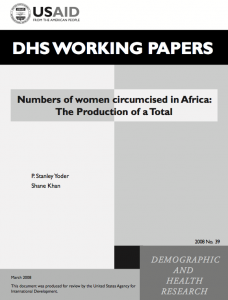 This report was written in response to a request from the World Health Organization’s Division of Family & Community Health, Department of Reproductive Health & Research, Gender, Reproductive Rights, Sexual Health & Adolescence team (FCH/RHR/GRR) to produce an estimate of the number of women in Africa who have been circumcised, or have undergone female genital cutting (FGC).
This report was written in response to a request from the World Health Organization’s Division of Family & Community Health, Department of Reproductive Health & Research, Gender, Reproductive Rights, Sexual Health & Adolescence team (FCH/RHR/GRR) to produce an estimate of the number of women in Africa who have been circumcised, or have undergone female genital cutting (FGC).
The World Health Organization (WHO), the United Nations Population Fund UNFPA), the United Nations Children’s Fund (UNICEF), the United States Agency for International Development, UNFPA, UNICEF, (USAID), and various NGOs have provided estimates of the “number of women and girls worldwide” who have undergone FGC, but those estimates vary widely and do not include information on how the numbers were obtained. Given the limitations of the data on FGC in some African countries, the team at Macro agreed to provide a number, but a number for women 15 years old and older, not one for “women and girls worldwide.” In order to provide a methodological context for that number, we have also written a brief report about how the numbers were produced for each country. Readers could then judge for themselves if the calculations seemed reasonable. In countries where FGC data are available from a national survey with a representative sample of women, most often from a Demographic and Health Survey (DHS), the calculations are straightforward. Where such data are lacking, the calculations involve a series of assumptions related to the various estimates available and the ethnic composition of the population.
The text provides a total number and accounts of its derivation for women 15 years old and older in African countries who have been circumcised. The estimates do not include girls younger than 15 years old, although Appendix A provides an estimate for girls 10-14 years old. Two types of data are needed for such calculations: a reliable estimate of the number of women 15 years old and older for each country, and a national prevalence rate for FGC for the same women. After a brief discussion of the importance of obtaining numbers as accurate as possible, the text describes the procedures used to estimate the numbers of women circumcised in countries with population-based national surveys. The next section describes how prevalence estimates were done for the countries without such data. The report concludes with a discussion of the assumptions made and the relative strength of the calculations used.
